c-Myc Antibody (A-14)
| Product name: | c-Myc Antibody (A-14) |
| Source: | Rabbit |
| Purity: | >95% |
| Buffer Formulation: | phosphate buffered saline , pH 7.4, 150mM NaCl, 0.02% sodium azide and 50% glycerol. |
| Applications: | WB, IP, IF, IHC, FC, ELISA, GS, ChIP |
| Storage: | For short-term storage, store at 4° C. For long-term storage, aliquot and store at -20ºC or below. Avoid multiple freeze-thaw cycles. |
| UOM: | 100ug |
c-Myc Antibody (A-14)
Catalog Number:ic209310
- 1
- 2
- 3
- 4
Product Profile
| Product Name | c-Myc Antibody (A-14) |
|---|---|
| Antibody Type | Tags Antibodies |
| ModificationNotes | c-Myc-, N-Myc- and L-Myc-encoded proteins function in cell proliferation, differentiation and neoplastic disease. Myc proteins are nuclear proteins with relatively short half lives. Amplification of the c-Myc gene has been found in several types of human tumors including lung, breast and colon carcinomas, while the N-Myc gene has been found amplified in neuroblastomas. The L-Myc gene has been reported to be amplified and expressed at high level in human small cell lung carcinomas. The presence of three sequence motifs in the c-Myc COOH terminus, including the leucine zipper, the helix-loop-helix and a basic region provided initial evidence for a sequence-specific binding function. A basic region helix-loop-helix leucine zipper motif (bHLH-Zip) protein, designated Max, specifically associates with c-Myc, N-Myc and L-Myc proteins. The Myc-Max complex binds to DNA in a sequence-specific manner under conditions where neither Max nor Myc exhibit appreciable binding. Max can also form heterodimers with at least two additional bHLH-Zip proteins, Mad and Mxi1, and Mad-Max dimers have been shown to repress transcription through interaction with mSin3. |
Key Feature
| Clonality | Polyclonal |
|---|---|
| Isotype | IgG |
| Host Species | Rabbit |
| TestedApplications | |
|
recommended for detection of c-Myc p67 and 9E10 Myc tagged fusion proteins of human and monkey origin by WB, IP, IF, IHC(P), FCM and ELISA; only minimal cross-reactivity with c-Myc of mouse and rat origin:
|
|
| Species Reactivity | |
| Concentration | 200 µg/ml |
| Purification | Affinity purified |
Target Information
| Alternative Names |
epitope mapping near the C-terminus of c-Myc of human origin
|
|---|---|
| Tissue Specificity | epitope mapping near the C-terminus of c-Myc of human origin |
Database Links
| Entrez Gene | 4609 |
|---|
Application
-
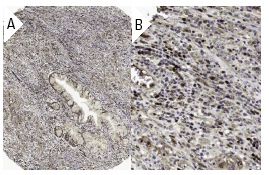
Application
Immunoperoxidase staining of formalin fixed, paraffin-embedded human cervical cancer tissue showing nuclear and cytoplasmic staining of tumor cells at low (A) and high (B) magnification. Kindly provided by The Swedish Human Protein Atlas (HPA) program.
-
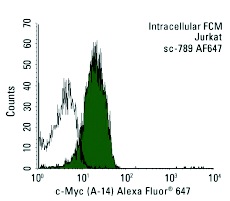
Application
Intracellular FCM analysis of fixed and permeabilized Jurkat cells. Black line histogram represents the isotype control, normal rabbit IgG: .
-
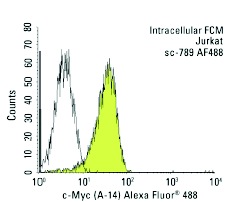
Application
Intracellular FCM analysis of fixed and permeabilized Jurkat cells. Black line histogram represents the isotype control, normal rabbit IgG: .
-
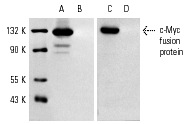
Application
Antibodies tested include c-Myc (A-14): (A,B) and c-Myc (A-14)-G: (C,D).
-
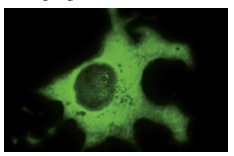
Application
Immunofluorescence staining of methanol-fixed COS cells transfected with c-Myc fusion protein showing cytoplasmic staining.
-
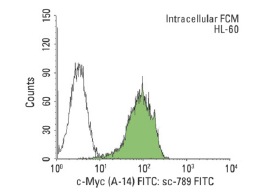
Application
Intracellular FCM analysis of fixed and permeabilized HL-60 cells. Black line histogram represents the isotype control, normal rabbit IgG: .
-
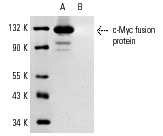
Application
Western blot analysis of whole cell lysates prepared from COS cells transfected with a c-Myc fusion protein (A) and non-transfected (B) cells.
-
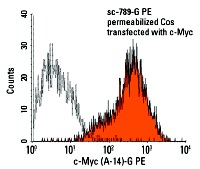
Application
Intracellular FCM analysis of methanol permeabilized COS cells transfected with c-Myc. Solid black line histogram represents control goat IgG.
-

Application
Intracellular FCM analysis of methanol permeabilized HeLa cells. Solid black line histogram represents control goat IgG.
| ApplicationNotes |
recommended for detection of c-Myc p67 and 9E10 Myc tagged fusion proteins of human and monkey origin by WB, IP, IF, IHC(P), FCM and ELISA; only minimal cross-reactivity with c-Myc of mouse and rat origin:
|
|---|
Additional Information
| Form | Liquid |
|---|---|
| StorageInstructions | For short-term storage, store at 4° C. For long-term storage, aliquot and store at -20ºC or below. Avoid multiple freeze-thaw cycles. |
| Storage Buffer | phosphate buffered saline , pH 7.4, 150mM NaCl, 0.02% sodium azide and 50% glycerol. |













